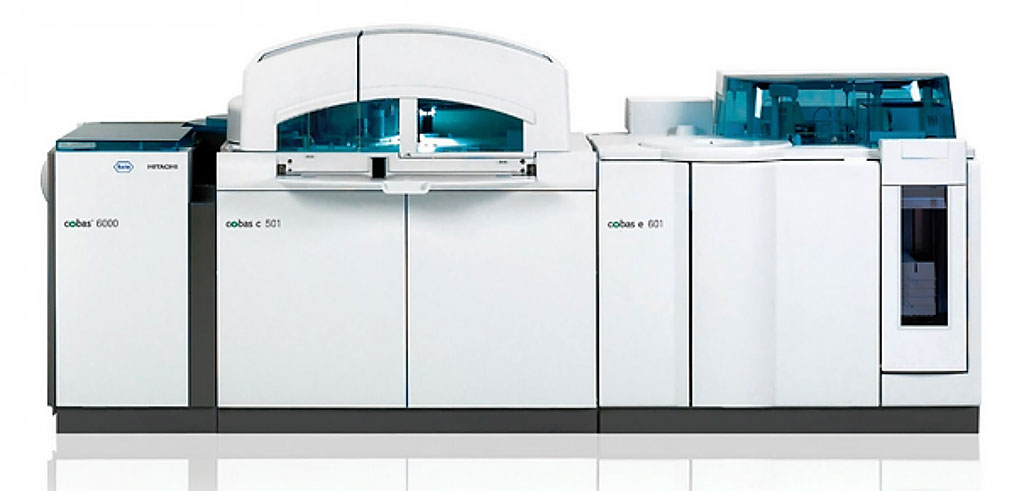Elevated PlGF Levels Found with Acute Fatty Liver of Pregnancy
|
By LabMedica International staff writers Posted on 22 Jul 2021 |

Image: The ROCHE Cobas 6000 Chemistry Analyzer (Photo courtesy of Roche Diagnostics)
Acute fatty liver of pregnancy (AFLP) is a severe liver disorder unique to pregnancy, typically occurring after 30 weeks’ gestation. Although uncommon, with an estimated global incidence of 1 in 7,000 to 15,000 pregnancies, AFLP is a life-threatening disease for both mother and child.
During preeclampsia, poor placentation triggers the excessive release of the soluble vascular endothelial growth factor receptors (VEGFR); also known as soluble Fms-like tyrosine kinase-1 (sFlt-1), which binds its free circulating ligands VEGF and placental growth factor (PlGF). The ensuing angiogenic imbalance is thought to contribute significantly to the clinical manifestations of this disorder.
Physicians at the Erasmus MC University Hospital (Rotterdam, the Netherlands) and their colleagues utilized human serum samples from a database of women with singleton pregnancies who had a clinical diagnosis of AFLP between 2005 and 2020. The team compared matched women with AFLP to 12 gestational age (GA) matched women with either no preeclampsia, confirmed preeclampsia, or HELLP syndrome, given that the values of sFlt-1, free, and total PlGF alter with advancing gestation.
Measurement of sFlt-1, Free PlGF, and Total PlGF was carried out. For the thermal dissociation of all sFlt-1-PlGF complexes, serum samples were placed in a heating block at 70 °C for 10 minutes. Measurements of sFlt-1 and PlGF before and after heating were performed using the automated Elecsys immunoassay from Roche Diagnostics (Cobas 6000, e-module; Rotterdam, the Netherlands).
The scientist found that median levels of free PlGF were significantly lower in 13 women with preeclampsia (117pg/mL) or in 12 women with hemolysis elevated liver enzymes and low platelet count syndrome (59 pg/mL) compared with 11 women without preeclampsia (349 pg/mL). In contrast, median total PlGF did not differ between women with no preeclampsia, preeclampsia, and hemolysis elevated liver enzymes and low platelet count syndrome (354 pg/mL versus 435 pg/mL versus 344 pg/mL) respectively, whereas it was markedly elevated in AFLP compared with all groups (2,054 pg/mL). Furthermore, in AFLP, both sFlt-1 and total PlGF declined rapidly post-delivery, with significantly higher in 12 pre-delivery total PlGF (median, 2,054 pg/mL) than 14 postpartum levels (median, 163 pg/mL), suggesting that in AFLP, PlGF is largely placenta-derived.
The authors concluded that their findings indicated that like sFlt-1, PlGF production is significantly upregulated in AFLP, mainly originating from the placenta. Importantly, total PlGF can now be easily calculated from already available free PlGF and sFlt-1 levels, allowing subsequent evaluation of other groups in whom PlGF is altered. The study was published on June 28, 2021in the journal Hypertension.
Related Links:
Erasmus MC University Hospital
Roche Diagnostics
During preeclampsia, poor placentation triggers the excessive release of the soluble vascular endothelial growth factor receptors (VEGFR); also known as soluble Fms-like tyrosine kinase-1 (sFlt-1), which binds its free circulating ligands VEGF and placental growth factor (PlGF). The ensuing angiogenic imbalance is thought to contribute significantly to the clinical manifestations of this disorder.
Physicians at the Erasmus MC University Hospital (Rotterdam, the Netherlands) and their colleagues utilized human serum samples from a database of women with singleton pregnancies who had a clinical diagnosis of AFLP between 2005 and 2020. The team compared matched women with AFLP to 12 gestational age (GA) matched women with either no preeclampsia, confirmed preeclampsia, or HELLP syndrome, given that the values of sFlt-1, free, and total PlGF alter with advancing gestation.
Measurement of sFlt-1, Free PlGF, and Total PlGF was carried out. For the thermal dissociation of all sFlt-1-PlGF complexes, serum samples were placed in a heating block at 70 °C for 10 minutes. Measurements of sFlt-1 and PlGF before and after heating were performed using the automated Elecsys immunoassay from Roche Diagnostics (Cobas 6000, e-module; Rotterdam, the Netherlands).
The scientist found that median levels of free PlGF were significantly lower in 13 women with preeclampsia (117pg/mL) or in 12 women with hemolysis elevated liver enzymes and low platelet count syndrome (59 pg/mL) compared with 11 women without preeclampsia (349 pg/mL). In contrast, median total PlGF did not differ between women with no preeclampsia, preeclampsia, and hemolysis elevated liver enzymes and low platelet count syndrome (354 pg/mL versus 435 pg/mL versus 344 pg/mL) respectively, whereas it was markedly elevated in AFLP compared with all groups (2,054 pg/mL). Furthermore, in AFLP, both sFlt-1 and total PlGF declined rapidly post-delivery, with significantly higher in 12 pre-delivery total PlGF (median, 2,054 pg/mL) than 14 postpartum levels (median, 163 pg/mL), suggesting that in AFLP, PlGF is largely placenta-derived.
The authors concluded that their findings indicated that like sFlt-1, PlGF production is significantly upregulated in AFLP, mainly originating from the placenta. Importantly, total PlGF can now be easily calculated from already available free PlGF and sFlt-1 levels, allowing subsequent evaluation of other groups in whom PlGF is altered. The study was published on June 28, 2021in the journal Hypertension.
Related Links:
Erasmus MC University Hospital
Roche Diagnostics
Latest Clinical Chem. News
- New Method Uses Pulsed Infrared Light to Find Cancer's 'Fingerprints' In Blood Plasma
- Carbon Nanotubes Help Build Highly Accurate Sensors for Continuous Health Monitoring
- Paper-Based Device Boosts HIV Test Accuracy from Dried Blood Samples
- AI-Powered Raman Spectroscopy Method Enables Rapid Drug Detection in Blood
- Novel LC-MS/MS Assay Detects Low Creatinine in Sweat and Saliva
- Biosensing Technology Breakthrough Paves Way for New Methods of Early Disease Detection
- New Saliva Test Rapidly Identifies Paracetamol Overdose
- POC Saliva Testing Device Predicts Heart Failure in 15 Minutes

- Screening Tool Detects Multiple Health Conditions from Single Blood Drop
- Integrated Chemistry and Immunoassay Analyzer with Extensive Assay Menu Offers Flexibility, Scalability and Data Commutability
- Rapid Drug Test to Improve Treatment for Patients Presenting to Hospital
- AI Model Detects Cancer at Lightning Speed through Sugar Analyses
- First-Ever Blood-Powered Chip Offers Real-Time Health Monitoring
- New ADLM Guidance Provides Expert Recommendations on Clinical Testing For Respiratory Viral Infections
- 3D Printed Point-Of-Care Mass Spectrometer Outperforms State-Of-The-Art Models
- POC Biomedical Test Spins Water Droplet Using Sound Waves for Cancer Detection
Channels
Molecular Diagnostics
view channel
Gene-Based Blood Test Accurately Predicts Tumor Recurrence of Advanced Skin Cancer
Melanoma, an aggressive form of skin cancer, becomes extremely difficult to treat once it spreads to other parts of the body. For patients with metastatic melanoma tumors that cannot be surgically removed... Read more
Blood Test Could Identify Patients at Risk for Severe Scleroderma
Systemic sclerosis, also known as scleroderma, causes the hardening of the skin and connective tissues. In many cases, the disease can also damage vital organs, including the heart, kidneys, lungs, and... Read moreHematology
view channel
New Scoring System Predicts Risk of Developing Cancer from Common Blood Disorder
Clonal cytopenia of undetermined significance (CCUS) is a blood disorder commonly found in older adults, characterized by mutations in blood cells and a low blood count, but without any obvious cause or... Read more
Non-Invasive Prenatal Test for Fetal RhD Status Demonstrates 100% Accuracy
In the United States, approximately 15% of pregnant individuals are RhD-negative. However, in about 40% of these cases, the fetus is also RhD-negative, making the administration of RhoGAM unnecessary.... Read moreImmunology
view channel
Stem Cell Test Predicts Treatment Outcome for Patients with Platinum-Resistant Ovarian Cancer
Epithelial ovarian cancer frequently responds to chemotherapy initially, but eventually, the tumor develops resistance to the therapy, leading to regrowth. This resistance is partially due to the activation... Read more
Machine Learning-Enabled Blood Test Predicts Immunotherapy Response in Lymphoma Patients
Chimeric antigen receptor (CAR) T-cell therapy has emerged as one of the most promising recent developments in the treatment of blood cancers. However, over half of non-Hodgkin lymphoma (NHL) patients... Read moreMicrobiology
view channel
Handheld Device Delivers Low-Cost TB Results in Less Than One Hour
Tuberculosis (TB) remains the deadliest infectious disease globally, affecting an estimated 10 million people annually. In 2021, about 4.2 million TB cases went undiagnosed or unreported, mainly due to... Read more
New AI-Based Method Improves Diagnosis of Drug-Resistant Infections
Drug-resistant infections, particularly those caused by deadly bacteria like tuberculosis and staphylococcus, are rapidly emerging as a global health emergency. These infections are more difficult to treat,... Read more
Breakthrough Diagnostic Technology Identifies Bacterial Infections with Almost 100% Accuracy within Three Hours
Rapid and precise identification of pathogenic microbes in patient samples is essential for the effective treatment of acute infectious diseases, such as sepsis. The fluorescence in situ hybridization... Read morePathology
view channel
New Error-Corrected Method to Help Detect Cancer from Blood Samples Alone
"Liquid biopsy" technology, which relies on blood tests for early cancer detection and monitoring cancer burden in patients, has the potential to transform cancer care. However, detecting the mutational... Read more
"Metal Detector" Algorithm Hunts Down Vulnerable Tumors
Scientists have developed an algorithm capable of functioning as a "metal detector" to identify vulnerable tumors, marking a significant advancement in personalized cancer treatment. This breakthrough... Read more
Novel Technique Uses ‘Sugar’ Signatures to Identify and Classify Pancreatic Cancer Cell Subtypes
Pancreatic cancer is often asymptomatic in its early stages, making it difficult to detect until it has progressed. Consequently, only 15% of pancreatic cancers are diagnosed early enough to allow for... Read moreTechnology
view channel
Pain-On-A-Chip Microfluidic Device Determines Types of Chronic Pain from Blood Samples
Chronic pain is a widespread condition that remains difficult to manage, and existing clinical methods for its treatment rely largely on self-reporting, which can be subjective and especially problematic... Read more
Innovative, Label-Free Ratiometric Fluorosensor Enables More Sensitive Viral RNA Detection
Viruses present a major global health risk, as demonstrated by recent pandemics, making early detection and identification essential for preventing new outbreaks. While traditional detection methods are... Read moreIndustry
view channel
Cepheid and Oxford Nanopore Technologies Partner on Advancing Automated Sequencing-Based Solutions
Cepheid (Sunnyvale, CA, USA), a leading molecular diagnostics company, and Oxford Nanopore Technologies (Oxford, UK), the company behind a new generation of sequencing-based molecular analysis technologies,... Read more
Grifols and Tecan’s IBL Collaborate on Advanced Biomarker Panels
Grifols (Barcelona, Spain), one of the world’s leading producers of plasma-derived medicines and innovative diagnostic solutions, is expanding its offer in clinical diagnostics through a strategic partnership... Read more






















